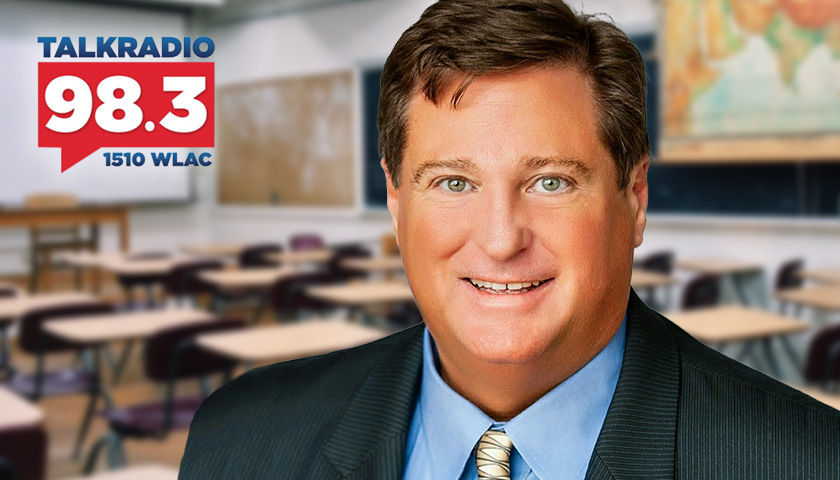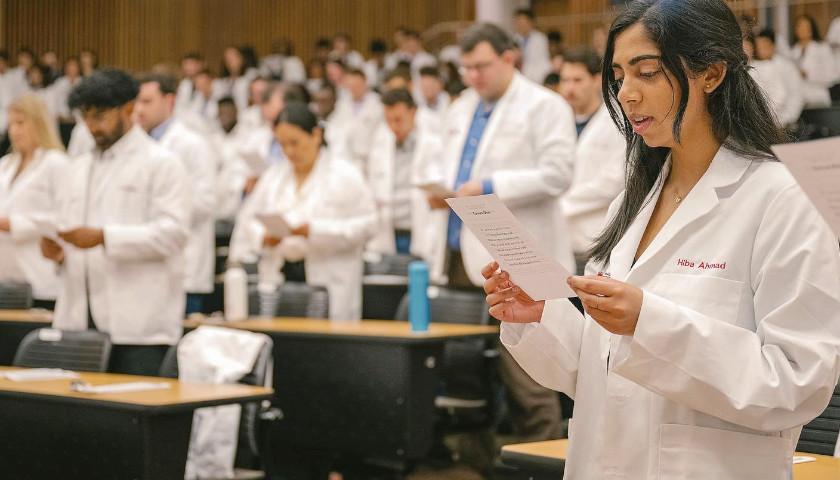Live from Music Row Tuesday morning on The Tennessee Star Report with Michael Patrick Leahy – broadcast on Nashville’s Talk Radio 98.3 and 1510 WLAC weekdays from 5:00 a.m. to 8:00 a.m. – host Leahy welcomed the Executive Director and CEO of Professional Educators of Tennessee, J.C. Bowman in studio to discuss the equity and mechanics of the Basic Education Program funding and how it will be dispersed.
Leahy: We are delighted to have in-studio our very good friend for many years, J.C. Bowman, President of Professional Educators of Tennessee. J.C., I’m still trying to figure out what is actually in this bill, Tennessee Investment for Student Achievement – TISA – and I’ve been looking and looking and looking. I know there’s going to be a lot more money spent on education, but what are the details?
The governor has had an opportunity since early January to lay out the details. They are still unknown. What are the details of this bill?
Bowman: Well, a couple of things. Number one, we had these committee meetings that were supposedly held and we were supposed to come up with ideas and talk about them.
And they didn’t have a plan supposedly developed, which we think that they did, but neither here nor there. When the plan rolls out, it included all the components of the previous plan, the BEP, we moved those over.
Leahy: Now eyes are glazing over. Let me translate: BEP equals what is a basic education program.
Bowman: That’s how you currently are funding public education.
Leahy: Now, the BEP, when you say how you’re currently funding education, that means the state has a big pile of money and it’s got to decide how much to give to Maury County and how much to give to Davidson County, right?
Bowman: Yes.
Leahy: And the BEP, they sit down, they have a formula, and they say, based on this formula, we’re going to give X per student to Maury County – or how does it work?
Bowman: And it also has an equalization piece to it. So it’s on your ability to pay. For example, if you’re in a rural community, you cannot pay as much, or if you’re in certain areas, you can’t pay as much.
There’s this equalization formula, which is very complex. And when everybody talks about BEP being complex, that’s the part that nobody understands.
Leahy: For our listening audience, perhaps, let’s say Marshall County is even more rural than Maury County. And it’s a smaller county. And then you have Davidson County an urban county, with lots of income, and then you have Williamson County, perhaps the most wealthy county.
Well, it is the wealthiest county. We might even compare those three counties if we were to sit down, and I would say to you, okay, how much money are you given per student in Marshall County under the BEP?
How much are you given to Williamson County under the BEP? And how much are you giving to Davidson County from the state? And would you be able to explain that process to me?
Bowman: Not really. (Laughter) In general, here’s how it would work. So, for example, if you pay $100 in Williamson County, you might get $48 back. So you’re going to lose money.
Leahy: When you say you pay $100 in Williamson County …
Bowman: In taxes. So state money and all that comes in, you may get a lower percentage.
Leahy: The state currently gives the more affluent counties less money per student.
Bowman: Because you have more ability to pay.
Leahy: Now in some cases more ability to pay …
Bowman: Because you are wealthier. You’ve got that money?
Leahy: Yeah, we got the money in Williamson County, the highest per capita income. Now let’s say lower per capita income in Marshall County, they would get more money back.
Bowman: Yes. They may put in say, for the $100, they may get $120 back, $130.
Leahy: That makes some sense. What’s it like in Davidson County?
Bowman: Davidson County has been – and that’s the other interesting thing. So when they calculate this out, they’re going, well, everybody knows with the new system that passes, we know without a doubt, 28 districts, in three years, the hold-harmless thing that they put on.
So basically, if TISA is such a great idea, let’s go ahead and implement it next year. It’s a great idea. Let’s implement it next year. But we’re going to do a hold-harmless. Now think about this. Now your eyes are glazing over.
Leahy: Hold-harmless. What does that mean?
Bowman: That means that you’re not going to lose any money. Everything’s the same. It’s going to be the thing. We’re just going to put in another $1.1 billion. But then we’re going to add $1.1 billion for these things called weights. So weights come along.
Leahy: So is it the case that you’re not going to get, as a county school district under this new program, less than you got last time, but then we’re going to put another $1.1 billion in, and then we’re going to figure out how to give that in some kind of equalized way to the various counties? Am I moving in the right direction?
Bowman: We’re just going to add it to them. And if more kids take career and technical education courses, we’re going to give them $5,000.
Leahy: Is that in the bill?
Bowman: Yes. We all know this, and it’s the unspoken truth. We talk about college and career readiness. We’ve all focused on college, but not every kid is going to go to college. So the governor is right about saying we need to spend money.
Leahy: Let me ask you this. Why should a kid go to college and learn to hate America when they could go to technical school and learn how to handle HVAC and plumbing and be a welder and a carpenter and make lots of money?
Bowman: A career in technical, but not all colleges are there. There are some good colleges out there.
Leahy: I would be shocked to find any college in the state of Tennessee where a kid comes in and when they get out, they love America more than when they went in. (Chuckles) Not your lane?
Bowman: We are K-12, we are K-12. But the governor would come back and argue – that’s why we’re trying to put more civics education, and we’re doing this.
And so the governor is attempting to try to address some of that. But back to this. We create these weights. So you create a weight for poverty. We’re going to create a weight for dyslexia, and I’ve been a champion for dyslexia.
Leahy: If you got more dyslexic kids …
Bowman: You’re going to get more money.
Leahy: You’re going to get more money.
Bowman: If more kids go to career technical, we’re going to give them more money.
Leahy: Well, here’s the problem. You get to the issue of fairness and equity here, don’t you?
Bowman: Well, that’s what they’re going to say, where it’s all equitable. The problem is, for me to be equitable I’ve got to take money from you to give money to me.
Leahy: You probably think that’s equitable but I’m thinking, what happened to my money?
Bowman: So back to this: If we give more money based on poverty – first off, I sit on a committee with some very smart people. Very good people. Very capable. I’m not going to name their names, but all the leaders of things, we couldn’t even come up with a definition for poverty, Michael.
I mean we sit here and argue over “are we going to do the free reduced lunch or are we going to use the federal poverty guidelines, are we going to create a third category?”
What are we doing? Are we’re talking about it? I don’t think we can even define what poverty is. But that aside, are we going to spend more money?
And all of a sudden if you have a poor kid in class and more money comes to that child, the money follows the child, does that money translate into better education? Is that kid going to get more books? What’s he going to get more of?
Listen to the interview here:
– – –
Tune in weekdays from 5:00 – 8:00 a.m. to the Tennessee Star Report with Michael Patrick Leahy on Talk Radio 98.3 FM WLAC 1510. Listen online at iHeart Radio.





